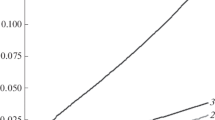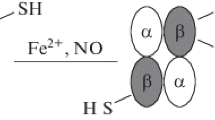Abstract
The oxidative modification of human hemoglobin (Hb) treated with hydrogen peroxide was investigated. Using the mass spectrometry method, the oxidized amino acid residues of the hemoglobin molecule were detected: αTrp14, αTyr24, αArg31, αMet32, αTyr42, αHis45, αHis72, αMet76, αPro77, αLys90, αCys104, αTyr140, βHis2, βTrp15, βTrp37, βMet55, βCys93, βCys112, βTyr130, βLys144, and βHis146. The antioxidant potential of the Hb molecule in the intracellular space and in the blood plasma is discussed.
Similar content being viewed by others
Avoid common mistakes on your manuscript.
In a living organism, reactive oxygen species (ROS), including hydrogen peroxide (H2O2), superoxide anion radical (\({\text{O}}_{2}^{{\centerdot - }}\)), hypochlorous acid (HOCl), and some other ROS, are always generated. They are highly reactive molecules that can attack target proteins, thus causing oxidative damage of proteins and ultimately affecting their spatial structure and mechanism of functioning. Importantly, unlike the plasma proteins, the protection of the intracellular proteins against ROS-induced oxidative damage is catalyzed by a wide range of antioxidant systems [1]. In addition, cells contain protein-disulfide reductase and methionine sulfoxide reductase, which reduce the oxidized cysteine and methionine residues to the original, unmodified form [2]. All this should provide a high tolerance of the intracellular proteins to the damaging effects of ROS. However, the release of these proteins from cells greatly reduces the possibility of their antioxidant protection.
In this study, we analyzed the posttranslational modifications of human hemoglobin (Hb) during its oxidation induced by hydrogen peroxide. Hb is an especially highly reactive molecule, which can be released into the extracellular medium in pathological states (e.g., hereditary hemolysis syndrome, etc.) or enter the bloodstream during the infusion of blood substitutes based on Hb [3].
The hemoglobin molecule is a tetramer consisting of two identical α subunits and two identical β subunits, the primary structure of which includes 141 and 146 amino acid residues, respectively. The secondary structure of α and β chains is formed solely by alpha-helical segments of different lengths (seven helical segments for α subunits and eight helical segments for β subunits), which are connected through nonhelical regions. Each globin subunit contains a “hydrophobic pocket,” which harbors the prosthetic group.
In this work, we used the commercial human hemoglobin preparation (H7379, Sigma, United States).
Protein oxidation was initiated with hydrogen peroxide (95321, Sigma, United States) at a fixed oxidizer/hemoglobin ratio of 1.3 × 10–5 mol H2O2/mg protein.
Electrophoresis was performed in a gradient polyacrylamide gel (8–23%) in the presence of sodium dodecyl sulfate (SDS) by the method of Laemmli. Protein was stained with Coomassie Brilliant Blue R250. To determine the molecular weight of the polypeptide chains of the studied protein, we used a mixture of marker proteins with molecular weights of 10 to 250 kDa (Precision Plus Protein Dual Color Standards, Bio Rad, United States).
Chromato-mass spectrometric analysis (HPLC–MS/MS) was performed in a system consisting of an Agilent 1100 automatic chromatograph with an automated sampling system (Agilent Technologies Inc., Santa Clara, United States) and a 7T LTQ-FT Ultra tandem mass spectrometer (Thermo, Bremen, Germany) [4, 5]. Samples were prepared for protein analysis as recommended by the manufacturer (Trypsin gold, V5280, Promega, United States). Measurements of each sample were performed in triplicate to ensure the reliability and reproducibility of the obtained data. The tryptic peptides were identified using the PEAKS Studio software (v. 8.5, Bioinformatics Solutions Inc., Waterloo, On, Canada). When comparing the results, the amino acids that were not oxidized in the control as well as the amino acids whose oxidation level increased by more than 1% compared to the control were taken into account.
The results of electrophoresis of the subunits of human hemoglobin unoxidized and oxidized with hydrogen peroxide are shown in Fig. 1.
It is known that, in a general case, the oxidation of proteins may be accompanied by chemical modification of amino acid residues in the protein, as well as by covalent crosslinking of the polypeptide chains or their fragmentation. Figure 1 shows that the electrophoretic mobility of the oxidized α and β subunits does not differ from that of the unoxidized subunits. This fact reliably indicates that the oxidation of the protein is represented only by modification of individual residues (i.e., no cross-linking or fragmentation of the chains takes place).
In the study of oxidative modification of the Hb molecule by mass spectrometry, we analyzed the Hb samples that were not subjected to induced oxidation (control) and the Hb samples that were treated with 1.3 × 10–5 mol Н2О2/mg protein (experiment). Both in the control and experimental samples, a number of peptide segments belonging to α and β subunits were mapped. We managed to obtain a very high percentage of detected peptides for hemoglobin subunits. In the control and experiment, the entire primary structure of α subunit (141 amino acid residues) was detected. In the case of β subunit, except the amino acid residues Val60 and Lys61, and other 144 amino acid residues were identified.
In the case of hydrogen peroxide-induced oxidation of hemoglobin, primarily the sulfur-containing cysteine residues (αCys104, βCys93, and βCys112) and methionine residues (αMet32, αMet76, and βMet55), as well as the aromatic radicals of tyrosine, tryptophan, and histidine (αTyr24, ΑTyr42, αTyr140, βTyr130, αTrp14, βTrp15, βTrp37, αHis45, αHis72, βHis2, and βHis146) are involved in modification. Mass spectrometry data also indicate chemical alterations of single residues of arginine (αArg31), lysine (αLys90 and βLys144), and proline (αPro77) (Fig. 2).
Mapping of the amino acid residues of hemoglobin in the sample at induced protein oxidation (1.3 × 10–5 mol Н2О2/mg protein) for alpha and beta chains. The percentage ratio indicates the ratio of the modified amino acid to the total amount of this amino acid in the peptide fragment. The detected and undetected regions are indicated with the gray and white color, respectively.
The effect of hydrogen peroxide on the oxidative modification of hemoglobin was also investigated in a number of studies [6–10]. In α and β subunits, a number of oxidized residues was identified, entirely including the sulfur-containing and aromatic amino acids. It should be noted that, in our study and in the studies by Pimenova et al. [6], Deterding et al. [7], and Jia et al. [10], the oxidized amino acid residues αTyr24, αTyr42, βTrp15, βMet55, βCys93, and βCys112 were identified. However, in our experiments, we detected no modifications of αHis20 and βTyr145, which were described in the above-cited papers [6, 7, 10]. We have also detected a number of previously unknown amino acid residues that underwent oxidation: αTrp14, αArg31, αMet32, αHis45, αHis72, αMet76, αPro77, αLys90, αCys104, αTyr140, βHis2, βTrp37, βTyr130, βLys144, and βHis146.
It is known that free-radical lesion of αTyr42 and βCys93 causes maximum damage to the structure of the protein region containing these residues and, thus, affecting the α1β2/α2β1 interface of the tetrameric hemoglobin structure [6]. In addition, irreversible oxidative modification of βCys93 and βCys112 followed by the oxidation of βTrp15 and βMet55 may dramatically disturb the β subunit structure as a result of H2O2 attack [10]. The primary hemoglobin structure comprises six tryptophan residues that are not exposed on the surface and, therefore, are relatively spatially inaccessible to ROS. The fact that βTrp15 and βTrp37 undergo oxidative alteration is due to loosening the α1β2/α2β1 tetrameric protein structure [10].
In conclusion, we would like to note that it was convincingly shown in the past years that protein oxidation is not a random process. In accordance with the site-specific oxidation concept, methionine (and, in some proteins, cysteine) residues function as antioxidants that can scavenge ROS and thereby protect other functionally significant amino acid residues from oxidative damage [11]. As we mentioned earlier, due to the action of reductases, the sulfur-containing residues of intracellular proteins can undergo reversible oxidation, which markedly increases their antioxidant status. This implies that the irreversible oxidation of methionine and cysteine residues in hemoglobin, apparently, does not allow them to protect a number of key tyrosine and tryptophan residues, which undergone oxidative modifications in the protein treated with hydrogen peroxide to the extent to which they would be protected in the intracellular hemoglobin. In addition, in terms of antioxidant protection, the very structure of hemoglobin seems less perfect compared to the structure of the plasma proteins. Indeed, even at low concentrations of hydrogen peroxide, the oxidation of βCys93 and βCys112 eventually leads to the structural collapse of Hb. The plasma proteins are believed to be adapted, to some extent, to the damaging action of ROS due to the fact that some of the structural parts of the proteins can shield other parts and key residues from oxidative damage [12]. This was convincingly demonstrated for the molecules of plasma fibrin-stabilizing factor and fibrinogen, which were found to be able to function under conditions of massive oxidation, because the posttranslational modifications did not involve the key amino acid residues that are responsible for the functionality of these proteins [5, 12].
REFERENCES
Grune, T., Biogerontology, 2000, vol. 1, pp. 31–40.
Groitl, B. and Jakob, U., Biochim. Biophys. Acta, 2014, vol. 1844, pp. 1335–1343.
Rifkind, J.M., Mohanty, J.G., and Nagababu, E., Front. Physiol., 2015, vol. 5, pp. 1–9.
Galetskiy, D., Lohscheider, J.N., Kononikhin, A.S., Popov, I.A., Nikolaev, E.N., and Adamska, I., Rapid Commun. Mass Spectrom., 2011, vol. 25, pp. 184–190.
Vasilyeva, A.D., Yurina, L.V., Indeykina, M.I., Bychkova, A.V., Bugrova, A.E., Biryukova, M.I., Kononikhin, A.S., Nikolaev, E.N., and Rosenfeld, M.A., Biochim. Biophys. Acta, 2018, vol. 1866, pp. 875–874.
Pimenova, T., Pereira, C.P., Gehrig, T., Buehler, P.W., Schaer, D.J., and Zenobi, R., J. Proteome Res., 2010, vol. 9, pp. 4061–4070.
Deterding, L.J., Ramirez, D.C., Dubin, J.R., Mason, R.P., and Tomer, K.B., J. Biol. Chem., 2004, vol. 279, pp. 11600–11607.
Ramirez, D.C., Chen, Y.R., and Mason, R.P., Free Radic. Biol. Med., 2003, vol. 34, pp. 830–839.
Mason, R.P., Free Radic. Biol. Med., 2004, vol. 36, pp. 1214–1223.
Jia, Y., Buehler, P.W., Boykins, R.A., Venable, R.M., and Alayash, A.I., J. Biol. Chem., 2007, vol. 282, pp. 4894–4907.
Kim, G., Weiss, S.J., and Levine, R.L., Biochim. Biophys. Acta, 2014, vol. 1840, pp. 901–905.
Rosenfeld, M.A., Vasilyeva, A.D., Yurina, L.V., and Bychkova, A.V., Free Radic. Res., 2018, vol. 52, pp. 14–38.
ACKNOWLEDGMENTS
This study was performed using the equipment of the Core Facility of the Emanuel Institute of Biochemical Physics, Russian Academy of Sciences.
Funding
Mass spectrometric studies were supported by the Russian Science Foundation (project no. 16-14-00181). The study was performed under budgetary financing within the framework of the State assignment (subject 0084-2014-0001) as well as was supported by the Russian Foundation for Basic Research (project no. 16-34-60244 mol_a_dk).
Author information
Authors and Affiliations
Corresponding author
Ethics declarations
The authors declare that they have no conflict of interest. This article does not contain any studies involving animals or human participants performed by any of the authors.
Rights and permissions
About this article
Cite this article
Vasilyeva, A.D., Yurina, L.V., Bugrova, A.E. et al. Peroxide-Induced Oxidative Modification of Hemoglobin. Dokl Biochem Biophys 486, 197–200 (2019). https://doi.org/10.1134/S1607672919030116
Received:
Published:
Issue Date:
DOI: https://doi.org/10.1134/S1607672919030116






